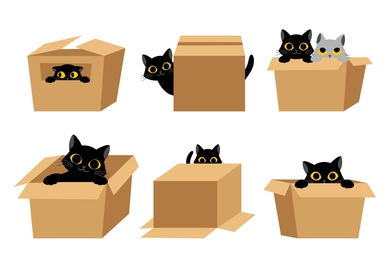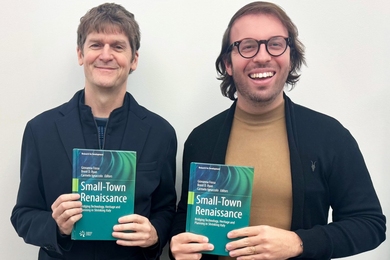It took a voice-mail message from her uncle Louie to convince New York Times reporter Amy Harmon that the average person is far more sophisticated about technology than she once thought. Uncle Louie, who she said "spends most of his time in Florida working on his tennis game," rambled on her answering machine about the pros and cons of the new Linux operating system.
"We conceptualize cyberspace as this other world, but there is now a fusion of those two worlds," said Ms. Harmon, one of six journalists to speak at MIT recently as part of "Journalism and Cyberspace," a pair of panel discussions organized by the Media in Transition Project. "People are more sophisticated about using the technology, but not about understanding the political and social implications of it," she said.
While some panelists emphasized that the Internet is a growing part of many Americans' daily lives, Ingrid Volkmer of the University of Augsberg in Germany sought to dissuade the audience from their "view of the Internet as a global medium." In fact, she said, the Internet is largely an American medium that is not used by most world citizens the way it is used by Americans.
Among other things, she noted, "in post-Communist Eastern Europe, the Internet is a source of a new emerging public discourse, but it has no global content," she said.
And while the growing numbers of Internet users in China, Malaysia and Singapore have state-controlled, censored and limited access, the vast majority of people in Africa have no access at all, Dr. Volkmer said. Africa is also not a major focus of media outlets such as CNN, which provides an Internet feed to Africa that is geared toward Europe, said Dr. Volkmer, a professor of media and communication. Of the 700,000-plus computer users on the immense African continent, she said, 600,000 are in South Africa.
COVERAGE WILL CHANGE
In America, newspapers are still more portable than a computer screen, but little about journalism will likely remain the same as digital technology becomes an increasingly integral part of Americans' daily lives, several panelists said.
Just as we no longer see newspaper stories about how to adjust the vertical hold on our TV sets, the panelists predicted that the detail-oriented coverage of the technology itself will go away. Meanwhile, they said stories grappling with how the new technology affects society will continue, at least into the immediate future.
"In our current moment of conceptual uncertainty and technological transition, there is an urgent need for a pragmatic, historically informed perspective that maps a sensible middle ground between the euphoria and the panic surrounding new media; a perspective that aims to understand the place of economic, political, legal, social and cultural institutions in mediating and partly shaping technological change," writes David Thorburn, MIT literature professor and organizer of the event.
The Media in Transition project is a joint venture of the MIT Communications Forum (sponsor of the events), the MIT Media Studies Program and the John and Mary R. Markle Foundation. The project aims to establish a conversation among scholars, engineers, fiction writers, journalists, corporate leaders and policy makers about the political and cultural significance of emerging communications media.
EARLY CYBERSPACE
Julian Dibbell, who writes for the Village Voice and other alternative press as a freelance journalist, started his career as a rock critic determined to "break down barriers between realms of high culture versus pop culture," he said. At some point, he realized that the record industry was not the oppressed cultural victim he had envisioned, and rock criticism became a job, not a vocation.
He then discovered the modem, and with it a whole realm in which barriers were being broken down much more rapidly than in the world of pop music. He started writing about the teenage hackers that dwelt in an alien place called cyberspace that few of the uninitiated had entered.
"There was an undertone that cyber-space was a deep, dark mysterious place that only members of the technological elite can penetrate," said Amy Harmon, a contemporary of Mr. Dibbell who claimed she was one of a small minority of interns who was offered a staff position on the Los Angeles Times because editors were impressed with her ability to use the newfangled thing called a modem.
Mr. Dibbell, as well as Ms. Harmon, who now covers cyberspace for the New York Times, were around for what Ms. Harmon called the "frontier phase" of the coverage. Coverage has since moved away from what panelist Hiawatha Bray, the Boston Globe's technology columnist, called the "freak show" aspects of the Internet to more commonplace uses.
Mr. Dibbell found that the golden age of a medium only happens once, and after it's passed, the pioneers of the field have to continue making a living even though the romance is over. And Ms. Harmon admitted that she looked at her parents' coming on-line as proof that the beat was going downhill.
Mr. Dibbell is still interested in exploring the cultural implications of the Internet. "Because the technology is so complex and so protean, you never know what part of people's lives it's going to reach," he said. The once-alternative story he covered from the underground has surfaced in the mainstream as a legal, political and business story.
COMMERCIAL ASPECTS
Unlike Ms. Harmon's and Mr. Dibbell's interest in writing about the social effects of the 'Net, Mr. Bray, a business reporter, revels in what he calls his "relentless pursuit of the mundane, which has its own magic and mystery. I want to bring about a vision of a world that works better.
"I hate hip," he declared, preferring to concentrate on the commercial practical aspects of the medium while leaving the cultural aspects of the Internet alone. As a black Baptist, he said, he hasn't found much to interest him personally among the cultural groups represented, although he acknowledged he was helping his church go on-line.
The session on November 5 was moderated by Jack Driscoll, former Boston Globe editor who is now editor-in-residence at the Media Lab. The November 12 session was moderated by James Carey of Columbia University, who noted that journalism has been redefining itself long before the Internet came along.
While readership continues to decline and most Americans get their news from TV, he said the Internet, the web and cyberspace all pose threats to established practices as well as opportunities for new ones.
NEW ROLES FOR PAPERS
Panelist Reid Ashe (SB 1970, electrical engineering), president and publisher of the Tampa Tribune, pointed out that newspapers have long been in the virtual reality business. "Newspapers give people the benefits of the central marketplace -- the social gathering place where people have traditionally exchanged news and views while conducting business -- without having to gather there physically," he said.
"We have defined our value by our ability to use the old tools," he said. "We haven't comprehended how to use the new tools to do things that have never been done before."
Still, newspapers may be able to transfer skills like collecting and disseminating information into new formats for cyberspace. Mr. Ashe also was excited by the idea that the Internet could provide truly local news that permeates to the level of the neighborhood -- a "neighborhood on line" through which people can explore the concerns of a community. People also now use news stories as opportunities to link with other people who share their interests.
With the advent of the Internet, newspapers' role as a "central processor" of information has diminished because people can now go directly to information sources. However, Mr. Ashe argued that there will still be a need for professionals who can gather and distill information as well as evaluate its accuracy for the public.
ADDED FEATURES
Rob Fixmer, technology editor of the New York Times, provided examples of how an Internet news story can differ from a traditionalone. "If we were going to succeed" he said of the launch of CyberTimes, the web-based version of the New York Times, "we had to do things in a different way."
This included providing, to accompany news stories, a tax calculator that allowed people to plug in their own income information to see how presidential candidate Robert Dole's proposed tax plan would affect them; a breast cancer quiz that allowed women to figure out whether they were good candidates for annual mammograms; and a computer simulation of a theory that said that people moved away from neighborhoods which were made up of less than a certain percentage of their own ethnic group.
"We always thought of ourselves as the gatekeepers," Mr. Fixmer said. "We dictated the contents of the front page and we trained NewYork Times readers how to use it. They know that the story in the upper right hand corner is the lead story and that the stories above the fold are more important than the stories below the fold."
The world of cyberspace offered new possibilities for readers, and newspapers had to learn how to present a story that was easy to navigate on the Internet and possible to navigate in ways that had never before been possible. "It was difficult to let the medium dictate" this, Mr. Fixmer admitted.
A version of this article appeared in MIT Tech Talk on November 25, 1998.





